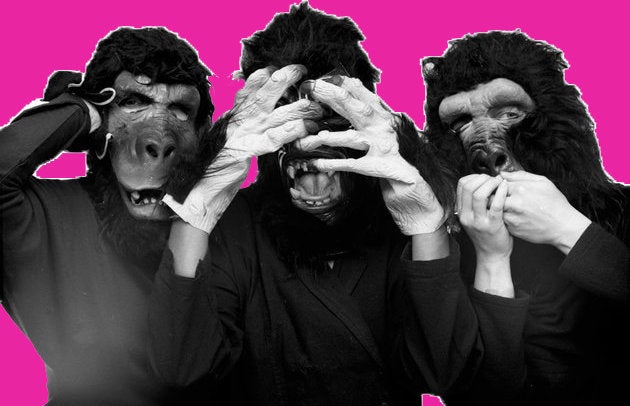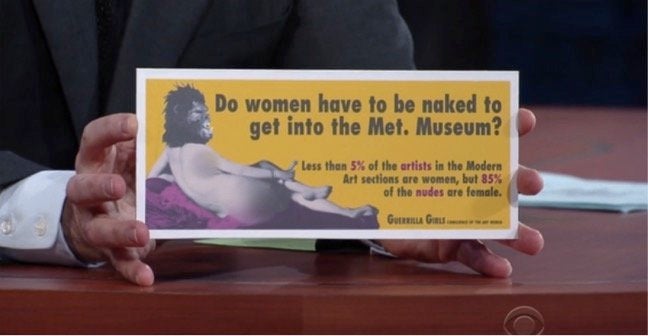
Did you happen to watch "The Late Show" on Wednesday night? Did you happen to catch a glimpse of three women in gorilla masks chatting with Stephen Colbert about the lack of women artists in museums?
It wasn't exactly your typical late-night scene, but according to CBS' website, it was not just a glorious fever dream I had. Kathe, Zubeida and Frida --pseudonymous members of the well-known feminist protest collective, the Guerrilla Girls -- did in fact take to the "Late Show" couch this week to discuss one of the hairiest problems the art world faces today: gender inequality.
To begin the segment, Colbert, who has become somewhat of a late-night voice on the topic of modern art, introduced his audience to one of the Guerrilla Girls most recognizable protest signs. "Less than five percent of the artists in the Met Museum are women," the sign reads, "but 85 percent of the nudes are female."

Women, the Guerrilla Girls habitually point out, are severely underrepresented in museums. "Right now, the art world is kind of run by billionaire art collectors who buy art that appeal to their values," Kathe explained, wearing her signature mask to hide her real identity. "We say, art should look like the rest of our culture. You know, unless all the voices of our culture are in the history of art, it's not really a history of art, it's a history of power."
I've written about the state of gender parity in art before. I've pored over the same stats: In 2013, every artist in the top 100 auction sales was a man. In 2014, there were no women in the top 40. In 2015, only five of 34 art galleries surveyed by the feminist art collective Pussy Galore boasted rosters in which women constituted more than 50 percent. The reality is: white men dominate the auctions, museums and galleries responsible for preserving art history and supporting emerging artists.
The masked Guerrilla Girls have been facing stats like these for over 30 years, and have responded by regularly creating protest art like the sign above in hopes of battling the systemic racism and sexism that plagues our creative industries. They began in 1985, under the leadership of seven anonymous women, and have been picking apart sexism in art, pop culture and politics ever since.

Toward the end of his show, Colbert reminded the women that in 1985, the Guggenheim, the Met and the Whitney had zero solo shows by women artists, and the Museum of Modern Art had a measly one. Unfortunately, after 30 years of protesting, not much has changed. The Guggenheim, Colbert noted, had one solo show by a woman artist last year, while the Met had one, the Whitney had one, and MoMA had -- wait for it -- two.
"Yeah, and that’s the progress we’ve made in 30 years," Zubeida replied. "And that’s the whole problem, because a lot of people thought that it was an issue in the ’70s and the ’80s and then it got solved, but it hasn’t. We still see such terrible numbers, and that’s why, sadly, we need to keep doing this."
The numbers are certainly depressing, but there's something beautiful about seeing a pretty radical art group on network television, talking about an issue many people would dismiss as niche. So, kudos to Colbert for tackling a topic most late-night hosts wouldn't dare to touch. And kudos to the GGs for receiving some well-deserved recognition.
Watch the full segment below.
For more on the Guerrilla Girls' "takeover" of the Twin Cities later this month -- including various events at small galleries, art centers, classrooms, major stages and a bowling alley -- head here.
Also on HuffPost:

